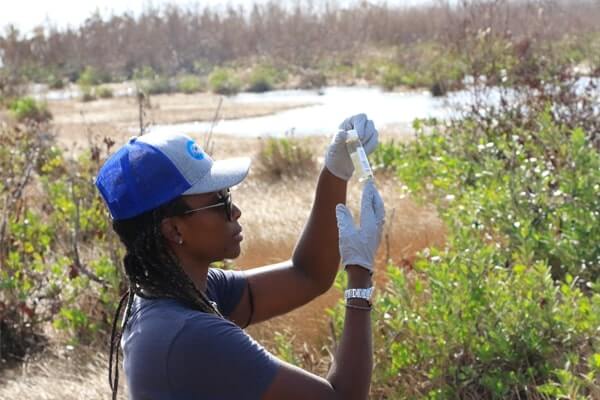Conservation Groups Call for Petroleum Policy Improvements, Better Transparency and Full Accounting of Dispersants Used, Following Exuma Spill
By: Waterkeeper Alliance

In response to the July 20 oil spill on Great Exuma, a coalition of environmental groups lauded the fast response, but called for improved spill prevention and preparedness as well as increased transparency and a full accounting of the steps taken to respond to the Exuma spill, including an analysis of quantity and type of the dispersants applied to the spill area. The groups point out the fragile nature of coral and seagrass ecosystems and note how dispersants, if misused, may significantly increase the toxicity and long term impacts of spill events in environments like the Bahamas. The group referenced several studies showing the particular vulnerability of coral ecosystems.
Initial estimates reported the spill to be approximately 35,000 gallons of diesel fuel that leaked during a fuel transfer from the tanker vessel MT Arabian, contracted by Bahamas-based Sun Oil, to a shoreside facility that generates electric power for the island. Reports indicate that the spill occurred during the overnight hours of 19-20 July, the long timeline indicating a potential lack of awareness that the spill was occurring.
“This was a significant, but preventable oil spill,” said Joseph Darville, Chairman of Save The Bays. “Better oil safety regulations are clearly needed to ensure this does not happen again. And if it does, that the flow of oil is promptly shut off.”
The groups acknowledge the government’s quick action, but note that the favorable conditions, in this case with oil contained close to shore, may not exist for the next spill.
“In this instance, the location of the spill, coupled with the decision to pull a floating boom across the mouth of the small bay, appears to have been helpful for maximum containment,” said Casuarina McKinney-Lambert, Executive Director of BREEF. “Unfortunately, the conditions of oil spills are unpredictable and response plans must account for that. It should also be assumed that in this case, some oil did escape, long term damage did occur, and that dispersants may have exacerbated this effect.”
The groups contend that estimates of recovered oil are highly optimistic. “Booming and skimming are not shown to be anywhere near 100% effective, so let’s be clear, damage did occur,” said Chris Wilke, Global Advocacy Manager for Waterkeeper Alliance. “We also know that once dispersants are used, booming and skimming become ineffective and evaporation largely ceases as the oil is now throughout the water.”
They call for an overhaul of petroleum spill prevention and response policies to better prevent and respond to future spills. Government officials on the scene that day expressed a “political will” to have the issue resolved within 24 hours. The groups assert that this is extremely unrealistic for a spill of this size. Dispersants have the effect of hiding oil from view, halting evaporation, and making the oil more available and harmful to organisms below the surface. The groups caution the government and responders against the continued use of dispersants in situations like the Exuma spill. In some situations dispersants might be used to keep oil from reaching a sensitive shoreline, but in this case, with oil already contained and already impacting a shoreline, dispersants would likely damage the environment rather than help it.
“This is a stark reminder that we need to do more with respect to petroleum policy,” said Rashema Ingraham of Waterkeepers Bahamas. “Like with the Equinor Spill on Grand Bahama in 2019, we were not prepared with the best possible response,” she continued, in reference to the Bahamas National Trust report that concluded that improvements are needed with respect to petroleum policy to ensure that polluters pay all costs for cleanup and remediation.
The groups also contend that an initial assessment could be more robust and transparent. The geographic extent of the spill should have been immediately identified through aerial flights, boat surveys, and beach surveys. Photos indicate oil was escaping and we should not assume that even a small amount escaping the boomed area is of minimal consequence.
They support the ongoing investigation of the impacts following the oil recovery phase, with additional long-term monitoring of the habitat to determine the potential for lasting damage to the shoreline, water column, flora, and fauna. These impacts should be mitigated and restoration work may be needed at the polluter’s expense.
The groups emphasize that this incident demonstrates that work must be done to improve response to oil spill incidents and to improve readiness. Key elements include contingency planning updates, pre-stationing of equipment, identifying trained response personnel who could be mobilized on short notice, government command of spill response, and transparent sharing of information to the public.
This incident shows potential shortcomings in safety procedures and equipment that could have prevented or lessened the severity of the spill, including earlier detection with proper crew attention. Some jurisdictions are now requiring pre booming of vessels during fuel transfers to immediately contain any escaped oil before it impacts the shoreline. The Bahamas may want to consider minimum standards for pre booming and crew monitoring during large fuel transfer operations. However, overall, the coalition applauds the Bahamian government and other agencies for their quick response.
“In spite of some questions, it is clear that quick action mitigated at least some of the impact,” added Darville. “This incident, along with persistent effects from past events like the Equinor site on Grand Bahama, which is still plagued by millions of gallons of crude oil, are dramatic teaching occasions. Previous governmental agencies left much to be desired in responding and rehabilitating that vast damaged area.”